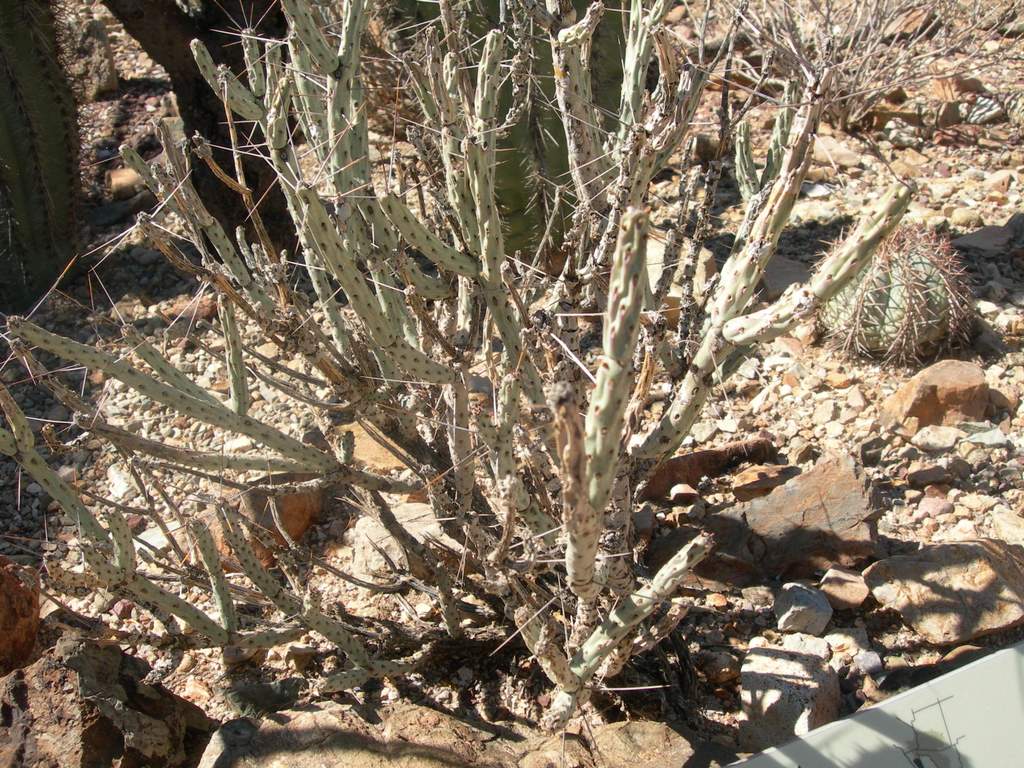Cylindropuntia
|
Family: Cactaceae |
Trees or shrubs, rarely forming mats, erect, usually many branched. Stem segments firmly attached to easily dislodged, straight to curved, cylindric to slightly clavate, 2-40(-50) × 0.3-5.5 cm, usually glabrous, tuberculate; areoles elliptic, circular, ovate, obovate, or obdeltate to rhombic, 0.7-5 mm diam.; wool white, yellow, or tan to brown. Spines with whole epidermis sheath deciduous; major spines not or only basally angularly flattened. Glochids usually in tuft at adaxial margin, yellow to brown. Flowers bisexual or sometimes functionally pistillate, radially symmetric; outer tepals green with margins tinged color of the inner; inner tepals yellow-green, yellow to bronze, or red to magenta, spatulate, emarginate-apiculate. Pollen spinulo-punctate, not reticulate (cylindropuntioid type). Fruits, if fleshy, green, yellow, or scarlet, sometimes tinged red to purple or, if dry, tan to brown, cylindric to subspheric, sometimes clavate, fleshy or dry, spineless or spiny; areoles bearing short feltlike wool of various colors, often tan or gray. Seeds pale yellow to tan or gray, flattened to subspheric, angular to squarish or circular, often warped, 1.9-7 mm, commonly bearing 1-4 large depressions per side due to pressure from adjacent developing seeds, glabrous; funicular girdle smooth or with low marginal ridge. x = 11. Interspecific cholla hybrids are known, and many have been named. Only two are fully treated here: Cylindropuntia ×kelvinensis, because it is so widespread, and C. ×tetracantha, because it has been confused with other hybrids. Additional named hybrids are described briefly and cross-referenced under the putative parental taxa entries.
PLANT: Trees or shrubs, erect, rarely creeping, much-branched. STEM: segments firmly attached to easily dislodged, of varied lengths, cylindric to slightly clavate, straight, glabrous. SPINES: with whole epidermis sheath deciduous; major spines not or only basally angularly flattened. FLOWER: inner tepals yellow-green, yellow to bronze, red to magenta, spatulate, emarginate-apiculate; outer tepals green with margins tinged color of inner tepals. FRUIT: FRUIT fleshy and green to yellow to scarlet, sometimes tinged red to purple, or dry and tan to brown, cylindric to subspherical, sometimes clavate, spineless or spiny. SEEDS: pale yellow to tan to gray, flattened, angular to squarish or circular, often warped, each commonly bearing 1-4 large depressions due to pressures from adjacent developing seeds, the girdle smooth or as a low marginal ridge. NOTES: 32 spp; Chihuahuan, Mohave, Sonoran Deserts, U.S. and Mexico; Caribbean. [Opuntia subgenus Cylindropuntia Engelm.]. (Latin: cylindrus = cylinder + Opuntia). REFERENCES: Pinkava, Donald J. 1999. Cactaceae. Ariz. - Nev. Acad. Sci. 32(1). |

